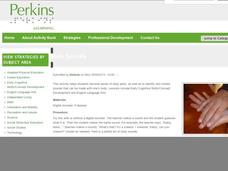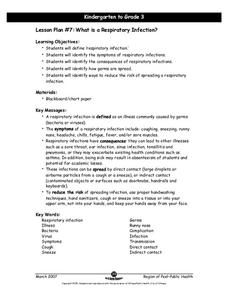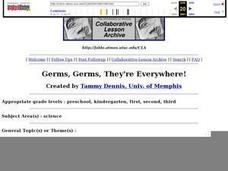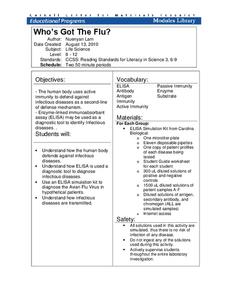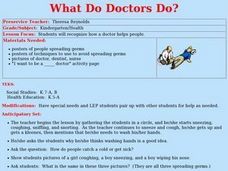Curated OER
Big Sneeze
Students discuss germs and how they get colds. They demonstrate the importance of covering their mouths while sneezing and what happens when the don't. They practice sneezing and coughing with a tissue.
Nemours KidsHealth
Colds and Flu: Grades 3-5
Two lessons from Kids Health Network aid in the prevention of cold and flu. The first lesson plan challenges scholars to read articles, discuss their findings, then create a PSA for proper prevention methods. The second lesson...
Curated OER
Cover Your Mouth Please!
Second graders investigate how to slow the spread of germs from coughing and sneezing. In this illness prevention lesson, 2nd graders talk about why people cough and sneeze before telling about ways to prevent the spread of germs. They...
Curated OER
Watch Germs Spread
Students demonstrate how germs spread from one person to another. They hide a small quantity of flour or cornstarch in their hand and then pretend to sneeze or cough into the hand. they shake hands with a child sitting nearby. They...
Perkins School for the Blind
Learning to Identify Sounds Made by the Body
Sneeze, snap, tap, and whistle; Did I do that? Explore the parts and sounds of the human body with your learners with visual impairments. First you'll name the parts of the body, make a sound with each part, and then have the class...
Nemours KidsHealth
Colds and Flu: Grades K-2
Two lessons identify three steps to prevent catching a common cold or the flu. The first lesson turns a familiar song into a friendly reminder to wash hands, cover your coughs, sneezes, and keep hands off your face. Lesson two...
Curated OER
The Human Body
Explore the human body through hands-on activities. Young learners will trace their bodies and place cut out body organs in the proper place, print patterns using cut fruit, sing songs about good nutrition, and use their five senses...
Curated OER
Germs: Learning Not to Share
Learners have cinnamon sprinkled onto their hands and walk around the room touching objects within their reach. Students observe all of the objects containing cinnamon fingerprints to visualize where and how germs are spread.
Curated OER
Making Germ Monsters
Young scholars explore germs. In this literacy and health lesson plan, students listen to the book Germs! Germs! Germs! by Bobbi Katz and discuss methods that prevent the spreading of germs. Young scholars cut symmetrical shapes out of...
Curated OER
Good Health Manners
Students read and discuss a list of Good Health Manners and examine how to avoid the flu. They complete a worksheet, and write why it is important to follow good health manners.
Centers for Disease Control and Prevention
Teach Mrs. Jones' Class about Microbes
During a biology lesson, scholars research microbes, design a lesson plan using an outline, and present the lesson to the class.
Henry The Hand
Good, Clean Fun!
Henry the Hand leads youngsters on an exciting adventure through coloring worksheets, word puzzles, and comic strips on everything they need to know about preventing the spread of germs by washing your hands.
PBS
Stories of Painkiller Addiction: Learning About Opioids
Feeling high is not the only side effect of abusing prescription opioids. Middle and high schoolers learn more about specific painkillers, including Fentanyl, Oxycodone, and Clonazepam, as well as their common brand names and extensive...
Peel-Public Health
What Is Respiratory Infection?
Give your youngsters a comprehensive introduction to the importance of washing hands and preventing the spread of germs in three activities, which include identifying what germs are, discovering where germs live, and practicing a...
Peel-Public Health
What Is Respiratory Infection?
Empower your pupils to be germ stoppers! The heart of these lessons lies in stopping the spread of germs and keeping clean hands in order to prevent cases like a respiratory infection. It includes a game to simulate how germs can...
University of Rochester
Common Cold – Self Care
When kids enter school, they often bring home new illnesses. Decode their symptoms, and help them to take care of themselves, with a fact sheet about the common cold. It delineates the symptoms one would experience as well as the signs...
Curated OER
Germs, Germs, They're Everywhere!
Youngsters recognize that germs are everywhere, and can make us sick. They identify ways that germs can be spread, see how they can prevent the spreading of germs, and learn appropriate hand washing techniques.
Curated OER
Good Drugs, Bad Drugs
Add a science experiment on medicine and drugs to your health lesson. After reading a paragraph on the difference between helpful and harmful drugs, kids choose which pictures of bottles they could find at a pharmacy. The last activity...
Curated OER
Immune, Lymphatic System
A fantastic slideshow that has images, details, definitions and trivia to accompany each structure and response involved with the immune system. The slides are very useful for all levels of the immune response. A complete sets of notes...
Centers for Disease Control and Prevention
Understanding the Epidemiologic Triangle through Infectious Disease
Introduce infectious diseases and the epidemiologic triangle. A helpful resource describes the agent, host, and environment from the three vertices as well as the time factor, which is in the middle. Scholars complete a simple...
Cornell University
Who’s Got The Flu?
Become an immunologist for the day. Scholars elicit the use of the enzyme-linked immunoabsorbent assay (ELISA) to diagnose an infectious disease. Through the process, they learn about the immune system response to infectious diseases.
Curated OER
What Do Doctors Do?
Students recognize how doctors help people and about germ spreading.
Curated OER
10 Tips for a Germ-Free School Year
In these reading comprehension worksheets, 5th graders read a story about 10 tips for a germ-free school year. Students then answer 5 reading comprehension questions about the text.
Utah LessonPlans
Disease Prevention and HIV/AIDS Education - First Grade
Identify behaviors that promote health and demonstrate personal hygiene.




